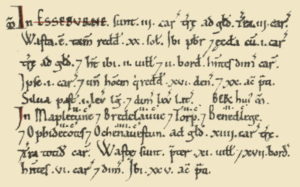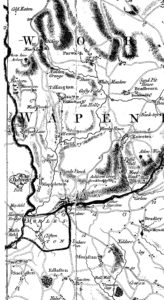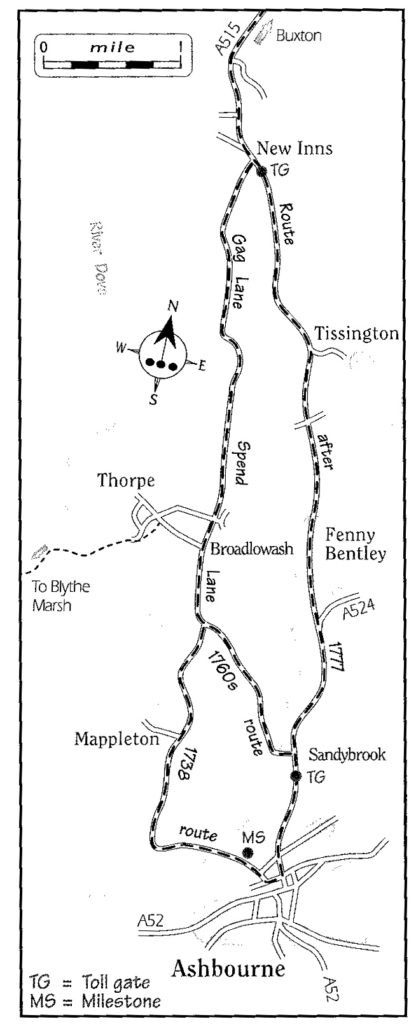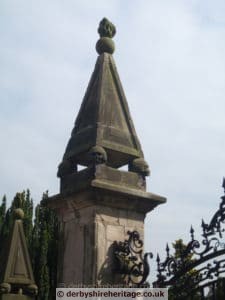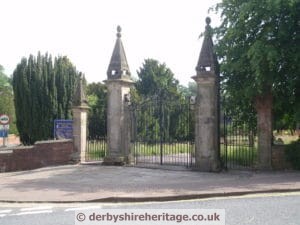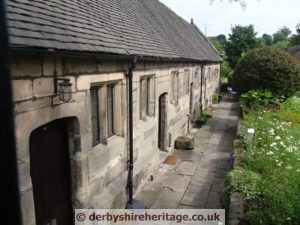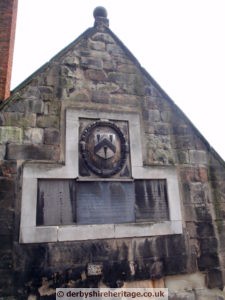ASHBOURNE is mentioned in the Domesday book as ‘Esseburne’ which means a stream by ash trees.
It is most likely that the settlement originated earlier in the Anglo-Saxon period, probably in the 8th or 9th century AD.
The Domesday book online lists the following –
Hundred: Hamston
County: Derbyshire
Total population: 4.9 households (very small).
Total tax assessed: 2.4 geld units (quite small).
Entry 1 for Ashbourne in Domesday Book
See larger image or on original page
Head of manor: Darley I.
Taxable units: Taxable value 17 geld units. Payments of 0.06 rent.
Value: Value to lord in 1086 £1.1.
Households: 13 villagers. 19 smallholders. 1 priest. 1 men.
Ploughland: 17 ploughlands (land for). 8 men’s plough teams.
Other resources: Meadow 45 acres. Woodland 1 0.5 leagues. 1 church. 1.0 church lands.
Lord in 1066: King Edward.
Lords in 1086: King William; priest, one.
Tenant-in-chief in 1086: King William.
Places mentioned in this entry: Ashbourne; Broadlowash; [Fenny] Bentley; Hognaston; Mapleton; Offcote; Thorpe.
Phillimore reference: 1,14
There were 45 places in the hundred of Hamston in Domesday Book
British History online records that the village of Ashbourne became a town in the 13th century when a market was established (see list of Derbyshire Markets and Fairs to 1516). Some websites list 1257 as the date of the market charter being granted but do not show a source reference for this.
British History online gives 1200 as Date of inception of market (The date of the charter, grant or first recorded mention of the market)
and Gazetteer of Markets and Fairs in England and Wales to 1516 shows for Ashbourne – “(Prescriptive: borough) mercatum, recorded 1222, held by William de Ferr’, earl of Derby. Held at the manor, which William held at farm from the king. The market at Clifton, Derbyshire (q.v.) was alleged to be detrimental to this market. A market, of which no details are given, was recorded on 31 Aug 1297, held by Sir Edmund, the king’s brother (CIPM, iii, no. 423). The manor had been granted to Edmund, earl of Lancaster in an exchange with K Edw I. In 1330, Henry, earl of Lancaster was holding a Sat market, which he claimed as an appurtenance of the manor.”
In the 1550’s exotic spices were being sold.
Ashbourne lies in a fairly shallow valley running NE to SW where the the Henmore Brook runs. Historically the town on the northern side of the Henmore Brook and South of the Brook a smaller settlement known as Compton developed. It also sits on a turnpike to Buxton.
The original Ashbourne Buxton turnpike route was via Mappleton and on to New Inns.
By 1770 this had been re-routed via Sandbrook and on to New Inns. Finally in 1777 the route was changed once again and from Sandbrook it passed through Fenny Bently, by Tissington gates and on to New Inns.
Burdett’s map shows the area in 1791.
ASHBOURNE HALL
A map of 1547 gives the impression of a rambling, gabled, timber-framed house, built around a courtyard, on which Edward Pegge paid tax on 10 hearths in 1670, making it Ashbourne’s largest house. In 1550 a track or road ran in front of the Hall.
It had a chapel dedicated to St. Mary near the gate from before 1477, which later became secularized and served as a malt house before being demolished c.1785.
It was built by the Cockayne, who were there from 155 or earlier until Sir Aston Cockayne was forced by poverty to sell to the Boothbys in 1671, at which time it was let to Edward Pegge, a solicitor. On 3rd December, 1745, Major General Sir William Boothby played host to Prince Charles Edward Stuart on his march to Derby. Records show that the trackway in front of the hall was closed in 1785 by the Boothby family, owners of the Hall, and incorporated into their landscaped park. In closing the road in front of the Hall, King Street was extended to the north of the Hall estate giving access to Wirksworth. At this time the park formed a huge swathe of land from King Street down to the Belper Road.
It was originally 3 storeys, with a 4 bay East front overlooking the park.
There was a serpentine lake, formed from the Henmore Brook and to the east of the Hall was an enclosed kitchen garden.
In the eighteenth century Sir Joshua Reynolds stayed to paint Penelope Boothby.
By 1830 the Hall had undergone much re-fashioning giving it a late 18th/early 19th century appearance.
Due to the extravagance of Sir Brooke Boothby the estate was mortgaged and on his death in 1846 was put up for sale In 1841 when it was withdrawn from sale at £27,950.
The hall was then sold by private treaty to John Fox an Ashbourne solicitor who then resold it to W B Hall and later acquired by Capt. Frederick Holland after a period of occupation by a Catholic priest. He died in 1860 and it was sold in March 1861 for £17,850 to R H Frankwho employed Benjamin Wilson of Derby to make alteratiobns. On Mrs Frank’s death it was sold in 1898 to R Holland.
In 1900 it was opened as a hotel but was later lived in by Holl;and’s nephew buy marriage Lt Cdr E G Boissier.
By the 1930s it was sold as lots and by 1948 converted into flats.
Within a few years most of the house had been destroyed.
Mr and Mrs R Cork bought and refurbished the hall in 2000.
ASHBOURNE CHURCH
St Oswald’s Church was dedicated 24 April 1241 by Hugh de Pateshull, Bishop of Coventry and Lichfield.
Replacing an earlier Saxon Church and possibly a second Norman one as a Norman crypt was discovered during excavations in 1913, construction started around 1240 and took until the early fourteenth century to complete.
From 1837 to 1840, it was restored by Lewis Nockalls Cottingham, and then in the 1870s by George Gilbert Scott, who added the battlements to the chancel.
Its 212 feet high spire dominates the town.
THere is an abundance of stained glass including a Christopher Whall window dated 1905 it was given to the church by Mr and Mrs Peveril Turnbull of Sandybrook Hall and it commemorates their daughters who died in a local fire.
Each of its transepts houses a chapel dedicated to leading local families. In the north transept, the Cockaynes, and the Boothbys (who bought their home Ashbourne Hall in the early 18th century). In the south transept is the Bradbourne’s chapel.
Ashbourne Church gateposts have their tops supported by skulls. They all have a skull at each corner.
It is thought that the gateposts were the work of Robert Bakewell one of Derby’s finest craftsmen. They date from 1700 and were set back a few feet from their original position in 1958, during road-widening.
from the Diocese of Derby website –
“Saint Oswald’s was consecrated on the 24th April 1241
The building, in a cruciform shape with the nave noticeably offset from the true, houses many tombs in the Boothby Chapel including that of little Penelope Boothby which boasts the most exquisite carving. Another of the many attractions is the Turnball Window, an Arts & Crafts stained glass window commemorating the deaths of Monica & Dorothea Turnball.
The church has a set of eight bells. These are rung, most unusually from the crossing, for Sunday services as well as at major festivals and events.”
Ashbourne Church in Wikipedia –
“The church is named after Oswald of Northumbria. A brass plaque in the chapel on the south side of the church commemorates its dedication on 24 April 1241 by Hugh de Pateshull, Bishop of Coventry and Lichfield.
Architecturally, it dominates the small town with its 212-foot spire which was referred to by George Eliot as the “finest single spire in England”. It is said to have been started in 1240 by Bishop Hugh de Pateshull. Construction probably lasted until the early 14th century. It replaced an earlier Saxon church, and possibly a second Norman one. (A Norman crypt was discovered during excavations in 1913.)
From 1837 to 1840, it was restored by Lewis Nockalls Cottingham, and then in the 1870s by George Gilbert Scott, who added the battlements to the chancel.
Until Ashbourne Hall was partially demolished, it and St Oswald’s were the town’s major monuments, standing at either end of the main street. The entrance to the hall’s grounds continued the main street through high gates. What remains of the hall houses the local lending library and some unrelated offices. As they were before the 18th century when the Boothby’s rebuilt and refurbished their home, St Oswald’s and its tower are once again the major landmark, and the church is the town’s main attraction. The church is a Grade I listed building.”
Founded 1669 and erected shortly afterwards. Ashlar. A single storey range at right angles to street.
Coupled 2-light mullioned windows throughout. Ledged doors in chamfered 4-centred arches. Stone gabled ends, that facing street has large armorial and inscribed panels with prolix Latin inscriptions. Modern or restored clustered stone stacks. Detached range of outbuildings opposite latrines etc erected 1848 in a similar style. Old tiles.
Owfield Almshouses, Ashbourne
Founded 1640 and erected shortly afterwards. Has much the same characteristics as Pegg’s Almshouses. Single storey and attics, the attic storey with 3 gabled dormers added 1848. 5 windows, 3 centre ones have coupled lights with mullions. 4-centred arches 2 of which are surmounted by panels bearing Latin inscriptions. Clustered stone stacks. Tiled roof with alternating double courses of curved and plain tiles. Coped gabled ends. they were enlarged with a second story added in 1848 with the addition of a second storey. There were originally 8 dwellings for poor widows and widowers who had a weekly allowance of 2s6d at the bequest of Roger Owlfield. In 1986, further substantial restoration was carried out and pairs of cottages were turned into one.
Ashbourne Green Man Hotel
Postcard from Old Derbyshire Postcards
The present inn was built in 1750, and is actually the result of two separate inns joining together. The Green Man has its origins in the Jack o’the Green, the main figure in medieval May Day festivities, put to death and then restored to life to comfort his disconsolate May Queen. He was no doubt originally a nature God, but later represented the Resurrection, hence his appearance in medieval carvings in churches as a head wreathed in leaves and foliage. The present Green Man sign depicting a hunter in a green jacket is an unfortunate modern idea. The present inn derived the addition of ‘Royal’ after Queen Victoria, when still a young princess, called in for tea one day. It became well-known through its connection with James Boswell and Dr Johnson. Indeed, as Dr Johnson remarks:
“There is nothing which has yet been contrived by man, by which so much happiness is produced as by a good inn or tavern “.
They never actually stayed there, but were given a meal by Mrs Killingley, the landlady, on one of Dr Johnson’s visits to his friend Dr Taylor. Boswell records:
“I took my post-chaise from the Green Man, a very good inn st Ashbourne, the Mistress of which, a mighty civil gentlewoman, curtseying very low, presented me with an engraving of the sign of her house; to which she had sojoined in her own handwriting, an address in such singular simplicity of style that I have preserved it, pasted upon one of the boards of my original journal at this time, and shall here insert itfor the amusement of my readers. M.Killingley’s duty waits upon Mr Boswell; is exceedingly obliged to him for thisfavour, whinever he comes this way, hopes for a continuance of the same. Would Mr Boswell name the house to his extensive acquaintance. It would be a singular favour conferred on one who has it not in her power to make any other return but her most grateful thanks and sincere prayers for his happiness in time and in a blessed eternity. “

